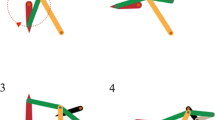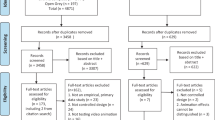Abstract
The primary purpose of this study is to examine the effectiveness of presenting animated video prompting (VP) in teaching car wash skills to individuals with mild intellectual disability (ID). In addition, it was aimed to investigate the permanence of the teaching, the generalizability of the acquired skill, and the opinions of the participants and their families in the research about animation VP. A multiple probe design with probe conditions across subjects, one of the single-subject research designs, was used in the study. The participants of the study were three males with mild ID, ages 18–24. The study's findings show that individuals with mild ID can learn the car wash skill using the VP method prepared with animations. The use of animation can facilitate the preparation of video-based content, and video-based instruction can become widespread. Further research can investigate whether there is a difference in effectiveness and efficiency between the animation VP methods and the VP methods prepared using camera records.





Similar content being viewed by others
Availability of data and material
References
Aljehany, M. S., & Bennett, K. D. (2019). A comparison of video prompting to least-to-most prompting among children with autism and intellectual disability. Journal of Autism and Developmental Disorders,. https://doi.org/10.1007/s10803-019-03929-x
Altun, D. E., & Özkan, ŞY. (2018). Serbest zaman becerilerinin öğretiminde hata düzeltmesi yapılarak ve yapılmadan sunulan video ipucunun karşılaştırılması. Ondokuz Mayıs Üniversitesi Eğitim Fakültesi Dergisi, 37(2), 15–33. https://doi.org/10.7822/omuefd.357700
Aykut, C., Emecen, D. D., Dayi, E., & Karasu, N. (2014). Teaching chained tasks to students with intellectual disabilities by using video prompting in small group instruction. Kuram Ve Uygulamada Egitim Bilimleri, 14(3), 1082–1087. https://doi.org/10.12738/estp.2014.3.1984
Baglama, B., Yucesoy, Y., & Yikmis, A. (2018). Using animation as a means of enhancing learning of individuals with special needs. TEM Journal, 7(3), 670–677. https://doi.org/10.18421/TEM73-26
Bennett, K. D., Gutierrez, A., & Honsberger, T. (2013). A comparison of video prompting with and without voice-over narration on the clerical skills of adolescents with autism. Research in Autism Spectrum Disorders, 7(10), 1273–1281. https://doi.org/10.1016/j.rasd.2013.07.013
Berney, S., & Bétrancourt, M. (2016). Does animation enhance learning? A meta-analysis. Computers & Education, 101, 150–167. https://doi.org/10.1016/j.compedu.2016.06.005
Cannella-Malone, H. I., Brooks, D. G., & Tullis, C. A. (2013). Using self-directed video prompting to teach students with intellectual disabilities. Journal of Behavioral Education, 22(3), 169–189. https://doi.org/10.1007/s10864-013-9175-3
Cannella-Malone, H. I., Miller, O., Schaefer, J. M., Jimenez, E. D., Page, E. J., & Sabielny, L. M. (2016). Using video prompting to teach leisure skills to students with significant disabilities. Exceptional Children, 82(4), 463–478. https://doi.org/10.1177/0014402915598778
Cannella-Malone, H. I., Sabielny, L. M., Jimenez, E. D., Page, E. J., Miller, M., & Miller, O. (2015). Use of continuous video prompting to teach a student with a significant disability. Journal of Developmental and Physical Disabilities, 27(6), 745–754. https://doi.org/10.1007/s10882-015-9448-y
Cannella-Malone, H. I., Wheaton, J. E., Wu, P. F., Tullis, C. A., & Park, J. H. (2012). Comparing the effects of video prompting with and without error correction on skill acquisition for students with intellectual disability. Education and Training in Autism and Developmental Disabilities, 47(3), 332–344.
Clinton, E., Galletta, A., & Zanton, J. (2016). Overview and critical components of video-based instruction for students with disabilities. Technology and Disability, 28(3), 91–100. https://doi.org/10.3233/TAD-160447
Dalacosta, K., Kamariotaki-Paparrigopoulou, M., Palyvos, J. A., & Spyrellis, N. (2009). Multimedia application with animated cartoons for teaching science in elementary education. Computers & Education, 52(4), 741–748. https://doi.org/10.1016/j.compedu.2008.11.018
Drysdale, B., Lee, C. Y. Q., Anderson, A., & Moore, D. W. (2015). Using video modeling incorporating animation to teach toileting to two children with autism spectrum disorder. Journal of Developmental and Physical Disabilities, 27(2), 149–165. https://doi.org/10.1007/s10882-014-9405-1
Gardner, S. J., & Wolfe, P. S. (2018). Results of a video prompting intervention package impacting dishwashing skill acquisition for adolescents with autism. Journal of Special Education Technology,. https://doi.org/10.1177/0162643418802666
Keen, D., Brannigan, K. L., & Cuskelly, M. (2007). Toilet training for children with autism: The effects of video modeling. Journal of Developmental and Physical DrysdaDisabilities, 19(4), 291–303.
Kellems, R. O., Charlton, C., Kversøy, K. S., & Győri, M. (2020). Exploring the use of virtual characters (avatars), live animation, and augmented reality to teach social skills to individuals with autism. Multimodal Technologies and Interaction, 4(3), 48.
Kellems, R. O., Sabey, C. V., Hansen, B. D., Frandsen, K. R., Clarke, B. M., & Simons, K. J. (2017). Does the noise matter? Exploring salient audio components in video prompting interventions. Advances in Neurodevelopmental Disorders, 1(4), 294–307. https://doi.org/10.1007/s41252-017-0036-2
Knight, V. F., Kuntz, E. M., & Brown, M. (2018). Paraprofessional-delivered video prompting to teach academics to students with severe disabilities in inclusive settings. Journal of Autism and Developmental Disorders, 48(6), 2203–2216. https://doi.org/10.1007/s10803-018-3476-2
Mayer, R. E., & Moreno, R. (2002). Animation as an aid to multimedia learning. Educational Psychology Review, 14(1), 87–99.
McLay, L., Carnett, A., van der Meer, L., & Lang, R. (2015). Using a video modeling-based intervention package to toilet train two children with autism. Journal of Developmental and Physical Disabilities, 27(4), 431–451. https://doi.org/10.1007/s10882-015-9426-4
Molseed, T. R., Alsup, J., & Voyles, J. (2003). The role of the employer in shaping students’ work-related skills. Journal of Employment Counseling, 40(4), 161–171.
Obrusnikova, I., & Rattigan, P. J. (2016). Using video-based modeling to promote acquisition of fundamental motor skills. Journal of Physical Education, Recreation & Dance, 87(4), 24–29. https://doi.org/10.1080/07303084.2016.1141728
Özbey, F., & Diken, İH. (2010). Zihinsel yetersizliği olan bireylerin iş-meslek eğitimi ve istihdamlarına yönelik Türkiye’de yapılan araştırmaların gözden geçirilmesi. Ankara Üniversitesi Eğitim Bilimleri Fakültesi Özel Eğitim Dergisi, 11(2), 19–42.
Rayner, C., Denholm, C., & Sigafoos, J. (2009). Video-based intervention for individuals with autism: Key questions that remain unanswered. Research in Autism Spectrum Disorders, 3(2), 291–303.
Richard, P. R., III., & Noell, G. H. (2018). Teaching children with autism to tie their shoes using video prompt-models and backward chaining. Developmental Neurorehabilitation,. https://doi.org/10.1080/17518423.2018.1518349
Weng, P. L., & Bouck, E. C. (2014). Using video prompting via iPads to teach price comparison to adolescents with autism. Research in Autism Spectrum Disorders, 8(10), 1405–1415. https://doi.org/10.1016/j.rasd.2014.06.014
Weng, P.-L., Savage, M. N., & Bouck, E. C. (2014). iDIY: Video-based instruction using iPads. Teaching Exceptional Children, 47(1), 11–19. https://doi.org/10.1177/0040059914542764
Funding
Not applicable.
Author information
Authors and Affiliations
Corresponding author
Ethics declarations
Conflict of interest
The authors have no conflicts of interest to declare.
Consent to participate
Before the study, all participants and their families were informed about the study in written and verbal form. Then, written consents of all participants and their families, indicating that they volunteered to participate in the study, were obtained.
Consent for publication
Provided that their real names are kept confidential, written permission was obtained from the participants and their families that the findings of the study could be used for scientific purposes and published.
Ethics approval
Research permission was obtained from Eskişehir Osmangazi University Social and Human Sciences Scientific Research and Publication Ethics Board.
Additional information
Publisher's Note
Springer Nature remains neutral with regard to jurisdictional claims in published maps and institutional affiliations.
Rights and permissions
About this article
Cite this article
Köse, H., Sönmez-Kartal, M. The effectiveness of video prompts created with animations in teaching car wash skills. Educ Inf Technol 27, 2083–2097 (2022). https://doi.org/10.1007/s10639-021-10698-7
Received:
Accepted:
Published:
Issue Date:
DOI: https://doi.org/10.1007/s10639-021-10698-7




